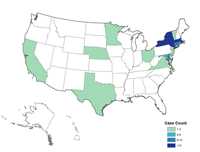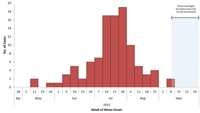Increase in Vibrio parahaemolyticus illnesses associated with consumption of shellfish from several Atlantic coast harvest areas, United States, 2013
Posted October 21, 2013 11:45 AM ET
Investigations
At a Glance:
See Interstate Shellfish Sanitation Conference for a list of Shellfish Closures, Reopenings, and Recalls.
More Information:
Latest Case Count Map
Latest Epi Curve
Highlights
- Read the Advice to Consumers »
- CDC and state and federal partners in 13 states are monitoring an increase in vibriosis since May 2013.
- As of September 30, 104 cases of a specific strain in 13 states with 6 hospitalizations and no deaths were reported to CDC.
- Vibrio bacteria live in saltwater. People can get vibriosis after eating raw or undercooked shellfish, particularly oysters. Several species of Vibrio, including Vibrio parahaemolyticus, can cause illness.
- There has been an increase in infections caused by a specific strain of Vibrio parahaemolyticus.
- These infections occurred among people who, in the week before they became ill, ate raw oysters or raw clams harvested along the Atlantic Coast.
- Before 2012, Vibrio parahaemolyticus infections of this strain were rarely associated with shellfish from the Atlantic coast.
- Symptoms typically consist of mild to moderate diarrhea, but can sometimes be severe, especially if the bacteria enter the bloodstream.
- Safe shellfish preparation is necessary to avoid illness, especially among high risk people. High risk groups include
- People with weakened immune systems
- People with chronic liver disease
- Public health investigators are using PulseNet, the national subtyping network of public health and food regulatory agency laboratories coordinated by CDC, to identify additional cases. PulseNet matches DNA "fingerprints" of Vibrio parahaemolyticus bacteria submitted by several states.
Investigation as of September 30
Public health investigators are using the national Cholera and other Vibrio Infections Surveillance (COVIS) system [PDF - 4 pages] to collect food histories. Food histories have been reported for 82 ill persons. Of these, 75 (91%) reported eating raw oysters or raw clams during the 7 days before their illness began.Â
State health departments work with regulatory partners to trace the source of the shellfish. These efforts have determined that raw oysters and clams consumed by Ill persons originated from shellfish harvest areas in Connecticut, Massachusetts, New York, and Virginia.
The Interstate Shellfish Sanitation Conference maintains a list of shellfish harvest area closures and recalls. Harvest areas to which illnesses were traced remain closed in Virginia (closed July 12) and Massachusetts (closed August 30). New York closed harvest areas which were associated with illnesses from June 29 to September 14and Connecticut closed illness associated harvest areas from August 2 to September 17. Massachusetts issued a recall of oysters originating from harvest areas associated with illness and Connecticut issued a recall of oysters and clams originating from illness associated harvest areas.
Illnesses are still being reported, but have decreased since the warmest months. It is unlikely that all harvest areas associated with illnesses have been identified. It is likely that many illnesses have occurred that were not detected through surveillance because some people do not seek medical care, diagnostic testing is not always performed, and some laboratories do not routinely use the specific culture plate necessary to test for Vibrio bacteria. The investigation is ongoing.
Contact Us:
- Centers for Disease Control and Prevention
1600 Clifton Rd
Atlanta, GA 30333 - 800-CDC-INFO
(800-232-4636)
TTY: (888) 232-6348 - Contact CDC–INFO
 ShareCompartir
ShareCompartir




